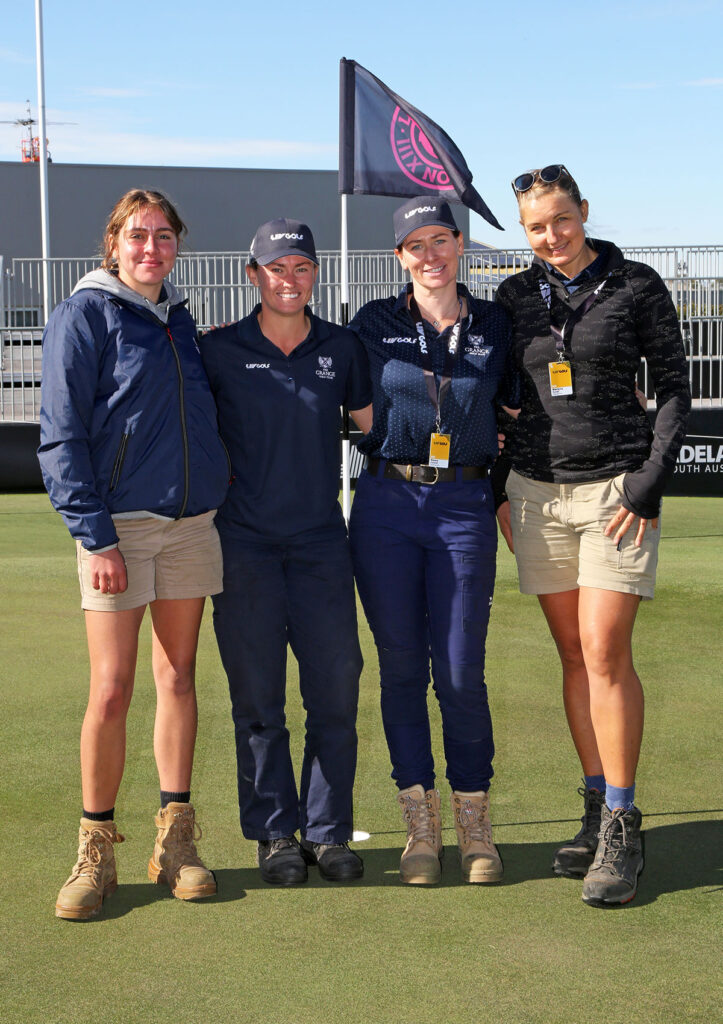Sandy Golf Links superintendent Gerri O’Callaghan says gender is no barrier to working in the turf industry for women who are seeking an outdoors career.
Gerri O’Callaghan says gender has never been a hindrance to an outdoor career in turf. She fondly recalls advice from her late father about work ethic. Gerry O’Callaghan impressed upon his daughter that she would earn respect by performing a job one-and-a-half times as well as a man.
Sadly, Gerry never got the chance to see his daughter embark on a turf career where she is now superintendent at Sandy Golf Links in Melbourne and where Gerri’s team maintains a public-access layout averaging about 250 rounds a day.
As such, O’Callaghan, 46, is this country’s most senior female turf manager, overseeing a layout ranked No.59 on Australia’s Top 100 Golf Courses that plays firm and fast like its siblings on the Melbourne Sandbelt.
“She’s certainly deserving of the role,” said Richard Forsyth, Royal Melbourne Golf Club’s director of courses. “She’s a very good communicator. She’s a good, easy-to-talk-to personality so she’s good in that role dealing with all those other aspects other than just the maintenance of the public golf course. We’re proud of her and we’re sure she’s going to do the place justice.”

Women in turf on the rise
The past five years has seen an influx of female apprentices into the turf industry. And more women are rising through the ranks into senior roles. This has been driven in part by the Women In Turf initiative conducted by the Australian Sports Turf Managers Association (for further information and employment opportunities, visit astma.com.au).
“It is a role for anybody. It’s not just a male-dominated industry anymore,” O’Callaghan says. “The girls that are in greenkeeping, they see all these opportunities coming along to win scholarships. It’s not, ‘Oh, the boys will win it.’ I certainly think the opportunities [are] now [there] for promotion.”
O’Callaghan’s journey in turf began rather innocuously while backpacking in London where she took a job mowing the carpark at the venue hosting the Henley Rowing Regatta. Upon her return to Australia, she landed a greenkeeping apprenticeship at Sandhurst Club in Melbourne. Her big break came when she was appointed assistant superintendent at the Sandringham public course, just across the road from Royal Melbourne. She later served as ‘foreman’ on RM’s East course before returning to Sandy during its reconstruction phase and then being elevated to the superintendent role in 2021.
As for tertiary study, O’Callaghan undertook a Certificate III in Horticulture (Recreational Turf) at what’s now Melbourne Polytechnic (formerly Northern Melbourne Institute of TAFE). She later completed a Diploma of Horticulture (Recreational Turf) there.
A turf apprenticeship encompasses learning about all the machines/equipment used on a golf course as well as their maintenance; installing irrigation and troubleshooting techniques; understanding drainage and how to remove excess water. They’re also taught grass identification, weed identification, chemical application and even arborary work – learning how to use a chainsaw.
“It certainly encompasses a lot of day-to-day activities on the golf course,” O’Callaghan says. “You might not use the same machine every single day. But you do get a very good overview of everything when you do the apprenticeship and the training that you undertake. It certainly sets you up for whatever job that you may come across on a golf course. Eventually, if you go on to do the Diploma you do more managerial [subjects].”
In the classroom, the topic matter that most intrigued O’Callaghan was the intricate nature of the different soils: learning about how quickly certain soils can drain; why they don’t drain properly and essentially what’s happening under the surface of the grass.
“A certain sward of grass can look very healthy, but then underneath there’s just so much going on with all the microbes and all the capillaries between all the sand. It’s not rocket science, but growing grass these days is quite scientific. With all the inputs that we have to put in – all the chemicals and pesticides – you have to be careful that you’re not damaging all the good bacteria under the soil for the grass to be healthy.
“For me, that was the fascinating side. You can take a plug and look at what underneath your green surface is doing. You can then work out from there, Do we need to add more fertiliser? Or do we need to add more water? So it becomes a juggling act of keeping that turf healthy – and not too wet and not too dry.”
Broadly speaking, ‘greenkeeping’ stems from horticulture: garden cultivation and turf management. There are specialist roles with golf-course maintenance, such as a spray technician, irrigation technician and biodiversity manager. Apart from golf courses, recreational turf management includes sports grounds (cricket and the football codes), lawn-bowling greens, grass tennis courts and horse-racing tracks.
Furthermore, the skillset and knowledge gleaned on the job and in the classroom prepares a turf manager to transition smoothly into another field of employment.
“As a greenkeeper, we can’t control the weather, so you have to be very adaptable,” O’Callaghan says. “You think about our trade, we pretty much do a little bit of everything – if you prepare the trench that you’re laying the irrigation [pipes]. Sometimes you might be putting some course furniture [into the ground] and so you become a carpenter for the day. There are so many little things that we do out on the golf course. I feel like a lot of it’s precision. It’s all aesthetics, so everything has to look good. It can then hold you in good stead when you go into other careers, the fact that you can do a little bit of everything.”
There’s certainly never a dull day on the golf course, O’Callaghan says.
“Just recently here at Royal Melbourne, we had quite a big leak in one of our stormwater pipes and we didn’t know where it went. So we had to investigate. Sometimes you get all the fancy equipment that you can use. You just learn all those sorts of things and you might not need it again for another five years.”

Hours, expectations and salary
A typical day at Sandy Golf Links begins at 6am since the first tee-time is about 7:30am. The maintenance crew is generally finished by 2:30pm on most days. Generally, apprentice greenkeepers have a standard 38-hour week from Monday-Friday.
“There would be expectation once you were more experienced for some weekend work… and a bit of overtime. Because obviously the grass keeps growing and golfers play all week,” O’Callaghan says. “Our busiest months are obviously the summer months. Then in the winter we take on other projects and more maintenance on the golf course that we just don’t get time to [undertake] in the summer.”
The wage for an apprentice greenkeeper is relatively modest. Starting pay for a first-year trainee is about $21 per hour (approximately $800 per week or $41,500 per year). However, it’s worth noting that salaries for superintendents at Australia’s most exclusive clubs can exceed $200,000, even $300,000 per year.
“It’s more of a passion, you love being outside or you love the idea of presenting a golf course. When the weather gets bad, sometimes it’s a bit hard for motivation. I’ve never found it an issue, just because I love golf and I love being outside,” says O’Callaghan, who sports a plus-1 handicap and has accumulated 11 club championship titles.
Opportunities for travel
The magnitude of the golf industry is such that certified turf managers are in demand, especially Australians who are well respected internationally for their skillset and work ethic. Hence, there’s opportunities to travel the world and it’s not unusual for a young apprentice to spend a northern summer at a reciprocal club in the United States or Britain.
While she is a passionate advocate for the turf industry, O’Callaghan cautions that a career in turf isn’t for everyone. “In certain times of the year it’s quite physically demanding – when you’re dragging a hose around, or you’re digging holes, or you’re changing all your mowing [equipment],” she says. “I find most nights that I’m pretty much ready for bed by about 9:30.
“Even when you’re on holidays, you’re up at the crack of dawn. I love that. I’m very much a morning person. So you see the sun rise. Sometimes you just take that 20 seconds to stop and go, Wow, look at the sunrise. Then hopefully you have a good day after that.”




